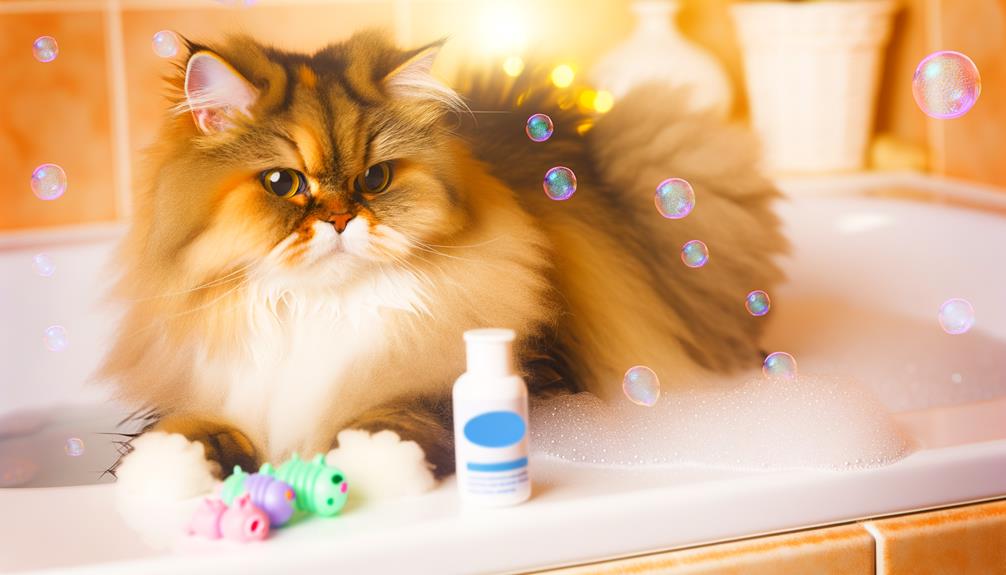After you've treated your cat for fleas, you might be wondering when it's safe to give them a bath without compromising the treatment's effectiveness. The timing can be essential as washing too soon may reduce the treatment's efficacy, but waiting too long might not be practical, especially if your cat loves exploring outdoors. You might also be curious about the types of flea treatments available and how they interact with water. Have you considered how the right bathing techniques and post-bath care can impact your cat's health and comfort? Let's explore these aspects further.
Timing for Bathing
Timing for bathing your cat after flea treatment is vital to guarantee the treatment's effectiveness. Understanding the appropriate waiting period can make the difference between a successful eradication of fleas and a potential re-infestation. When you apply a topical flea treatment like FRONTLINE PLUS, it's important to wait at least 24-48 hours before giving your cat a bath. This period allows the treatment to fully absorb into your cat's skin and become effective.
Bathing your cat too soon after application can wash away the treatment, thereby diminishing its efficiency. This could result in the need for reapplication and increased stress for both you and your cat. For products like Advantage II for Cats, a similar waiting period of 24 hours is recommended before you can consider it OK to bathe your cat. This guarantees the treatment has enough time to distribute through the sebaceous glands, providing thorough protection against fleas.
If you're using waterless flea shampoos, be aware that their effectiveness can vary greatly. Always adhere to the manufacturer's instructions regarding timing and application to achieve the best results. These guidelines are designed to optimize the treatment's efficiency and guarantee the safety of your pet.
It's important to always check the specific product labels for any unique bathing guidelines or waiting periods. Each flea treatment may have its own set of instructions that are essential for maintaining the treatment's effectiveness. By following these guidelines, you'll ensure the flea treatment works as intended, keeping your cat flea-free and healthy.
Types of Flea Treatments
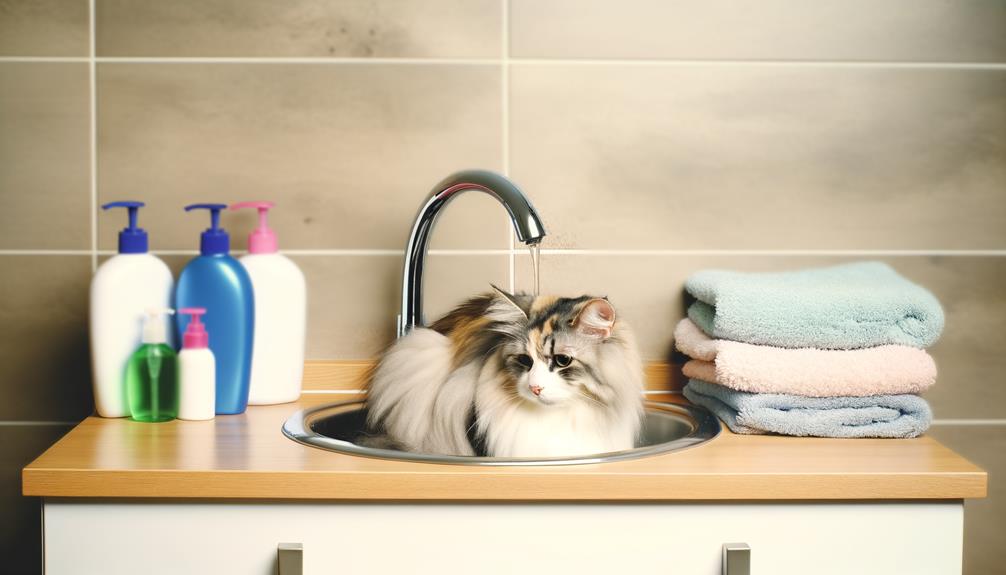
When considering flea treatments for your cat, it's crucial to understand the differences between topical solutions, oral medications, and flea collars. Topical treatments, like Frontline and Advantage, are applied directly to the skin and typically require a waiting period before bathing. In contrast, oral medications such as Capstar provide systemic protection and often don't necessitate a delay before washing your cat.
Topical Flea Treatments
Understanding topical flea treatments is important for effective flea management in your cat. Topical flea treatments, such as FRONTLINE PLUS, are formulated to absorb into the skin and remain effective even when your cat gets wet. However, it's essential to follow specific guidelines regarding bathing to guarantee the treatment's maximum efficacy.
Typically, you should wait at least 24 hours after applying a topical flea treatment before bathing your cat. This waiting period allows the product to fully absorb into the skin, optimizing its effectiveness. Bathing too soon could wash away the treatment, diminishing its efficacy and potentially leading to a flea reinfestation.
Certain topical flea treatments may necessitate a longer waiting period, ranging from 48 to 72 hours post-application. Consequently, always refer to the product's specific instructions for accurate guidance. Adhering to these recommendations is critical to maintaining the treatment's potency.
Oral Flea Medications
Just as topical flea treatments provide an effective means of managing flea infestations, oral flea medications offer an alternative that can be equally efficacious. Brands like Comfortis or Capstar are specifically formulated to kill fleas rapidly, guaranteeing your cat gets quick relief from the discomfort associated with these pests.
One significant advantage of oral flea medications is that they don't leave a residue on your cat's skin or fur. This means you can safely bathe your cat immediately after administering the medication without compromising its efficacy. Most oral flea treatments begin to work within hours, effectively eliminating fleas within 24 hours. This rapid action is particularly beneficial for severe infestations, providing quick relief and improving your cat's well-being almost instantly.
However, it's vital to adhere to any specific instructions provided with these medications. Consulting your veterinarian is advisable to determine the most suitable oral flea treatment for your cat's specific needs. Regular administration, typically on a monthly basis, is essential to maintain continuous protection against flea infestations. By following professional guidelines, you can guarantee that your pet remains flea-free and healthy.
Flea Collars Usage
Many pet owners turn to flea collars as a reliable method for managing flea infestations in cats. These collars offer continuous protection, typically lasting between 5 to 8 months depending on the brand and formulation. There are two primary types of flea collars:
- Insecticide-Releasing Collars: These collars kill fleas upon contact by releasing insecticides.
- Natural Ingredient Collars: These use natural repellents that are SAFE TO USE and non-toxic.
Some flea collars, such as Seresto, utilize a slow-release mechanism to distribute active ingredients gradually. This guarantees long-lasting protection as the ingredients spread through your cat's fur and skin.
When considering flea collars as part of your flea treatments, it's vital to monitor your cat for any adverse reactions. Some cats may be sensitive to the chemicals or materials used in the collars. Always consult the product labels for specific instructions regarding proper usage, safety precautions, and compatibility with other flea treatments to confirm they are SAFE TO USE for your pet.
To summarize, flea collars can be an effective and convenient option for flea control. Remember these key points:
- Choose the appropriate type of collar.
- Monitor your pet for adverse reactions.
- Follow product labels for safety guidelines.
- Confirm compatibility with other treatments.
Impact on Efficacy
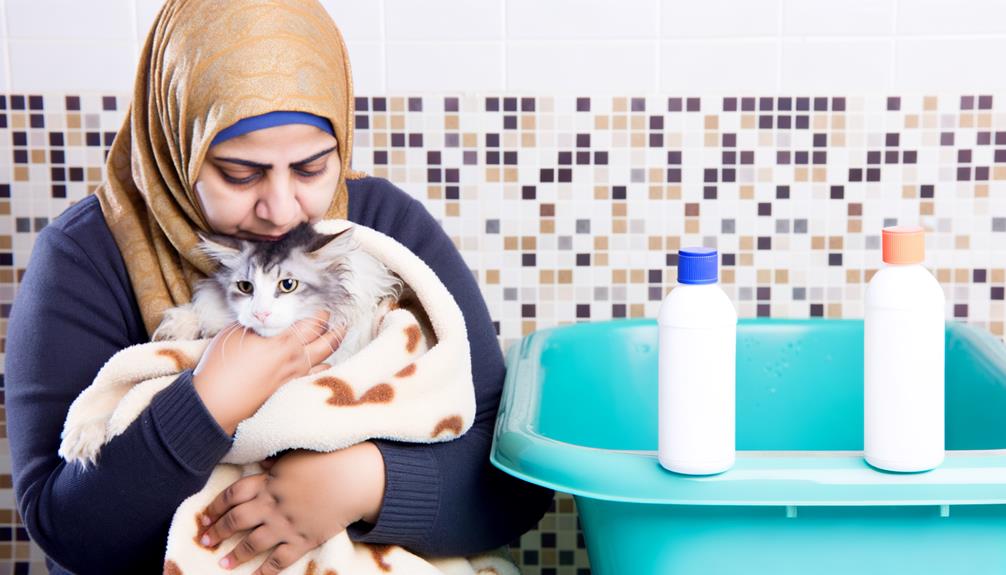
Bathing a cat too soon after flea treatment greatly diminishes the product's efficacy, as it can wash away the active ingredients before they've fully absorbed into the skin. For effective flea control, it is essential to allow treatments like Frontline PLUS sufficient time to permeate and establish a protective barrier. Typically, for topical treatments such as Frontline PLUS, a waiting period of at least 24 to 48 hours is recommended before bathing your cat. This timeframe guarantees that the active ingredients have adequately bonded to your cat's skin and fur, maximizing the treatment's effectiveness.
When flea treatment is washed off prematurely, it disrupts the intended chemical barrier designed to kill and repel fleas. This interruption not only reduces the immediate efficacy of the treatment but also can lead to a more challenging and persistent flea infestation. Some treatments, like Advantage II, become waterproof after a certain period. However, even these treatments suggest avoiding bathing within the first 24 hours post-application to achieve the best results.
Regular bathing without considering the timing relative to flea treatment can create a cycle of reduced effectiveness. Each time the active ingredients are diminished by early washing, the flea control process resets, leaving your cat vulnerable to flea bites and the associated risks. Consequently, adhering strictly to the recommended guidelines for post-treatment bathing is essential. By doing so, you guarantee that the flea treatment functions as intended, offering continuous protection and reducing the likelihood of recurring infestations. Maintaining proper timing between treatments and bathing is a vital step in sustaining effective and lasting flea control for your feline companion.
Bathing Techniques
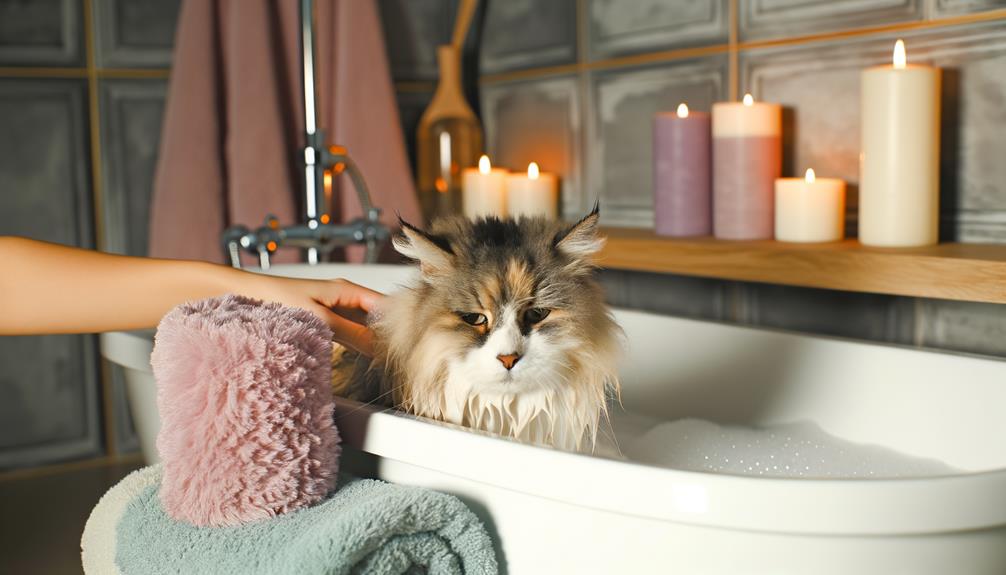
Proper bathing techniques are vital to guaranteeing your cat's comfort and the effectiveness of flea treatments. When you're ready to give your cat a bath, it's essential to follow these expert guidelines to maximize the benefits and minimize any potential discomfort for your feline friend.
- Use Lukewarm Water: Always use lukewarm water to bathe your cat. This temperature is most comfortable and helps to relax your pet, making the process less stressful for both of you.
- Flea-Specific Shampoo: Utilize a flea-specific shampoo to effectively target and eliminate fleas. Confirm you thoroughly lather the shampoo to reach your cat's skin, where fleas tend to reside. Complete coverage is vital for maximum flea removal.
- Rinsing Thoroughly: After shampooing, it's imperative to rinse your cat thoroughly to remove all shampoo residues. Leftover product can irritate your cat's skin and interfere with the effectiveness of subsequent flea treatments. Make sure there's no residue left behind.
- Dry Before Applying Flea Treatment: Once the bath is complete, dry your cat well with a towel. Immediate drying is necessary to prevent your cat from getting cold and to avoid drafts. Confirm your cat is entirely dry before applying any flea treatment to guarantee its maximum efficacy.
During the entire bathing process, monitor your cat closely to prevent slipping or accidents. Safety should always be a priority to guarantee a secure and stress-free experience for your pet. By adhering to these techniques, you can effectively maintain your cat's comfort and enhance the success of flea treatments.
Health Considerations
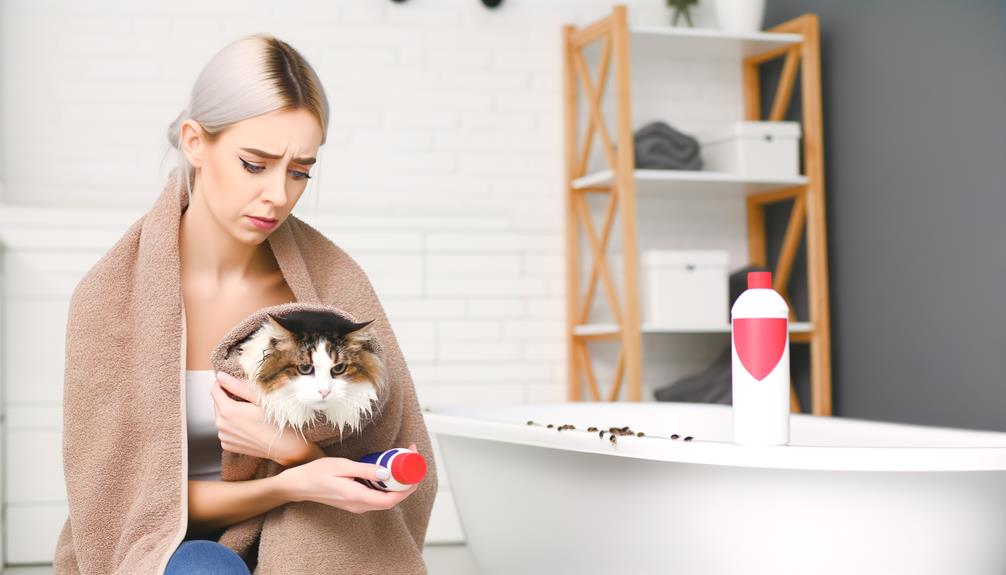
When considering the health implications of bathing your cat post-flea treatment, it is vital to understand the timing and choice of products. Bathing too soon can wash away the medication, reducing its effectiveness and potentially leading to re-infestation. As a result, you should wait at least 24 to 48 hours after applying topical flea treatments. This waiting period allows the medication to be fully absorbed into the cat's skin, ensuring it works as intended.
Health considerations extend beyond just the effectiveness of the flea treatment. Monitoring your cat for any adverse reactions after both the treatment and the bath is significant. Some cats may experience irritation or allergic responses to the products used. If your cat starts acting weird, such as excessive scratching, licking, or displaying unusual behavior, you should consult your veterinarian immediately. These could be signs of an allergic reaction or other health issues.
Choosing the right shampoo is another important aspect. Always use gentle, pet-specific shampoos. Human shampoos can be too harsh for feline skin, potentially causing irritation or dryness. This irritation can compromise your cat's overall health, making them more susceptible to infections.
After the bath, ensuring your cat stays dry and avoiding drafts is important. This helps prevent them from catching a chill, which is particularly significant if they've just been treated for fleas. A cold or other health issues could arise if they remain damp for too long in a cool environment.
Post-Bath Care
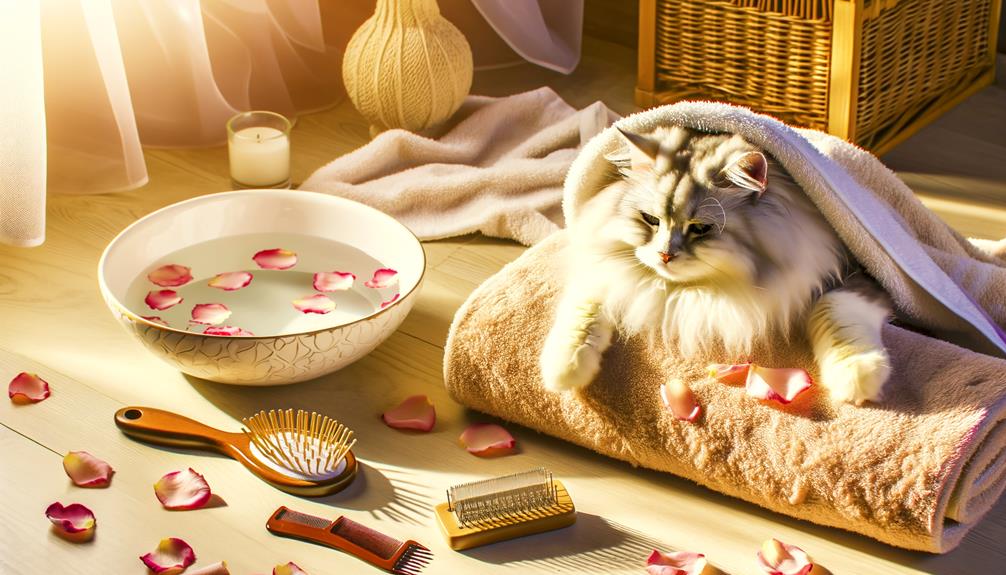
After bathing your cat, it's crucial to meticulously monitor them for any signs of irritation or allergic reactions, especially following recent flea treatment. This vigilance guarantees that any adverse effects are promptly addressed, maintaining your cat's overall health and well-being.
Post-bath care involves several critical steps:
- Thorough Drying: Verify your cat is thoroughly dried post-bath to prevent chills and maintain comfort. Damp fur can lead to skin issues, increasing the risk of fungal or bacterial infections. Using a towel gently, or a low-heat setting on a hairdryer if your cat is accustomed to it, can expedite the drying process.
- Utilize a Flea Comb: After your cat is dry, use a flea comb to check for any remaining fleas. This fine-toothed tool is effective in removing both live and dead fleas, as well as flea dirt, confirming that the flea treatment has been successful. Regular combing can also help monitor for future infestations.
- Calm Environment: Keep your cat in a calm environment post-bath to reduce stress. Stress can compromise the immune system, making your cat more susceptible to infections and other health issues. A quiet, warm space with familiar bedding will help them recuperate and relax.
- Maintain Flea Prevention Schedule: Consistency is key in preventing future infestations. Adhere to a regular flea prevention schedule, which includes timely flea treatments and thorough cleaning of your cat's environment. This holistic approach not only protects your cat but also minimizes the likelihood of recurring flea problems.
Implementing these post-bath care practices guarantees your cat remains healthy, comfortable, and free from flea-related complications.
